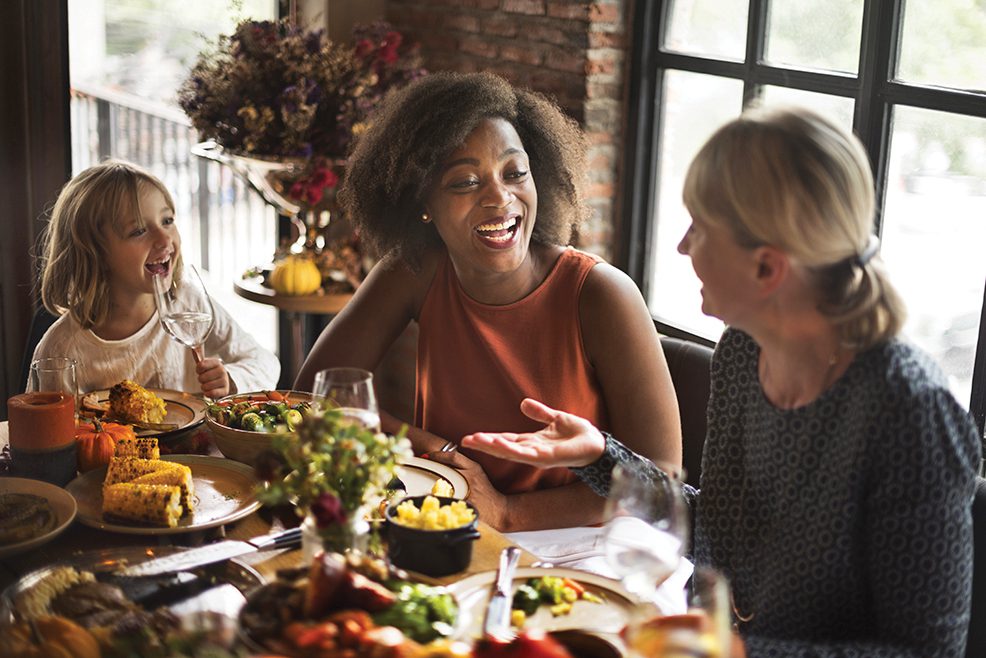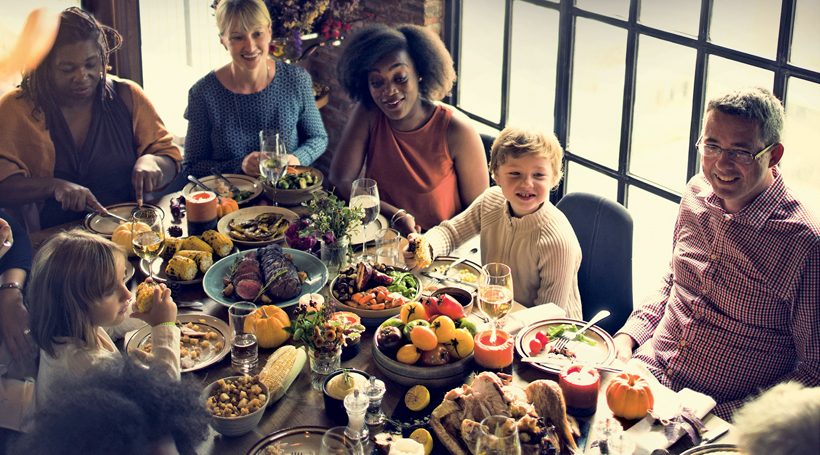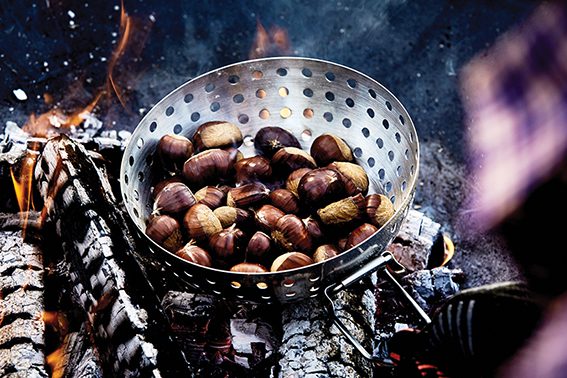This year, holiday hosts will be pulling out all the stops, but not like you think. The decor no longer has to be perfect. Table settings needn’t be extravagant. All of the effort for this year will go into making sure everyone who gathers feels a special connection. After a year of so much time apart, friends & family are planning to celebrate exactly the way they want most: together.
It’s a new holiday season – one that’s focused less on what’s on the table and more on who’s sitting around the table.
We won’t sugar-coat it: Last year’s holiday season was rough. In 2020, we couldn’t have those traditional celebrations, where siblings, in-laws, grandparents, aunts, uncles, cousins, friends – really anyone outside of your immediate household – gathered together to share food. But now, we’re heading into a brighter holiday season, where being together holds new meaning.
“This year, we’re planning everything around being able to have more quality time,” says celebrity chef Aaron McCargo, whose spectacular (but not overly-complicated) cooking won him top spot on “The Next Food Network Star” and his own Food Network show, “Big Daddy’s House.”
“People want to catch up, eat good food, share good drinks and have good conversations. However big and extravagant or paired-down the event is, it’s all going to come back to that.”
But our holidays likely aren’t going to look like they did last year, he adds. Or even the years before.
“On the other hand, we’ve all had about 2 years to comb through TikTok and Pinterest, to try recipes we’d never even think to try before.”
“It looks like events are going to go one of 2 ways,” says McCargo. “One: People realized they can have a lowkey holiday without all the bells and whistles, and they’re heading into the season without some of the shirt-and-tie, more formal traditions they had in the past.”
Others will go in the opposite direction. “On the other hand, we’ve all had about 2 years to comb through TikTok and Pinterest, to try recipes we’d never even think to try before,” he says. “People were shut inside for so long, and they found a creative outlet in the kitchen. People are even still making bread – something most people never had the time or patience for before. Armed with these new skills, I think a lot of people are going to blow the tablecloths off the tables in excitement.”
Whichever direction families go, he says, both approaches have one thing in common: At its core, we’ll be focusing on the people we love. And for a lot of people – food is the way to their hearts.
“People want to show off everything they’ve learned over the past few years. That means the new and exciting side dishes, the homemade bread, the professional-looking desserts,” says McCargo. “But they aren’t doing it because they want to brag – they’re doing it because they want to create something that says ‘I love you, and I’m so glad to be here with you.’ That’s the difference.”

“People are being more intentional about what they’re buying, where the food they’re buying is coming from, what companies they’re supporting,” he says. “There’s a push toward supporting local growers at farm markets or buying from companies that have the same values.”
That’s certainly been true in South Jersey, says David Hodges, market director of the Collingswood Farmers’ Market.
“For the past year, people have been starting to look at food and labor differently,” says Hodges. “They have started to shift to buying local, more ethical. We’ve seen this year, more than any other year in the 20 years I’ve been involved with the Collingswood Farmers’ Market, that supply chains can be interrupted by anything. We definitely saw that when a virus that was first reported in Asia ended up disrupting the supply chains for virtually every product that moves around the world.”
There’s no supply chain better, shorter or more reliable than buying your food directly from the person who grows it, he says.
“It’s a one-step chain – the farmer grows it, and he reaches his hands out to give you the food. That’s it. That’s the chain,” says Hodges.
 That interaction makes what you’re buying about the people behind it, not just the food.
That interaction makes what you’re buying about the people behind it, not just the food.
“People want to help their neighbors, they want to be a part of their communities,” he says. “Supporting local growers is not only an opportunity to meet a lot of tremendous people, it has a real sense of purpose, like we’re actually saving businesses,” says Hodges. “We’re actually saving farms. We’re actually making people healthier. We’re actually building community.”
You can see that same mentality in homes as well. People want their guests to feel welcomed and cared for, says McCargo, but not at the expense of enjoying their own holidays.
“It’s such a cliché, but you really can tell when someone’s made a dish specifically to show you they care. You can taste it, you can feel it in the effort they put in, you can see it in the presentation. That’s something I think we’re all looking forward to this year.”
No matter what the get-together looks like, this year, people are looking for connection, not perfection. And that’s something a lot of harried holiday hosts can get behind.
 High-Key Holidays, Low-Key Effort
High-Key Holidays, Low-Key Effort
Just a few special touches can bring added warmth to your celebration. Aram Mardigian, executive chef of the American Bar & Grille, Borgata Hotel Casino & Spa, has a few holiday kitchen hacks.
Mix up your presentation
It’s not about making a dish that’s incredibly fancy – just make it look fancy. “The presentation can make all the difference,” says Mardigian. “I have a simple, easy recipe for an Italian chestnut soup, but a lot of times people don’t want to sit and have a whole bowl of soup. I put them in little cappuccino or espresso cups with a drop of truffle oil and a drizzle of crème fraîche and put them out for people to grab and sip. It’s cozy, mingle-friendly and a real crowd pleaser.”
Add some local fruits
Small touches can go a long way in making a dish look, taste and smell special. “When you’re serving something like pork chops, it’s so easy to grab some local apples or peaches and cook them up with a little cinnamon, some brandy and a bit of butter and brown sugar,” he says. “It takes minimal effort and instantly elevates any dish.”
Break up the prep
“We’ve all been there – you try to do everything yourself, so by the time your guests get there you aren’t quite ready and you’re so frazzled and sweaty from running around all day that you can’t enjoy yourself,” says Mardigian. “If there was ever a time to avoid that, it’s this year.”
When you’re cooking for a group, there’s no reason to cook everything the same day, he says. There are things you can prep up to 3 days ahead of time – whether that means peeling and chopping vegetables or cooking entire meals that you’ll be able to pop right back in the oven the morning of. “For vegetables like potatoes, apples or pears that may brown quickly after you cut them, all you have to do is submerge them in lemon juice and water to keep them fresh for around 24 hours. Just place it in a Ziploc bag in the refrigerator.”
Think through your portions
There is nothing – absolutely nothing – worse than not having enough food. But that fear often leads to cooking way too much. Portion control is the way to go, says Mardigian. For protein, he suggests factoring in about 4-6 ounces of meat per person, making sure to take any outliers into account. “If you have a cousin or an uncle that you know is always going to eat twice as much as everyone else, don’t forget that, because they’ll eat everything whether there’s enough or not.”
Ask for help
Doing everything on your own is an avoidable burden. “Having people bring dishes makes planning so much easier, and the meal is a lot more interesting because it reflects more of the group,” he says. Ask for help, but proceed with caution, he warns. “Make sure you know what everyone’s go-to recipes are. If Aunt Mary makes an amazing artichoke dip, have her bring that. But if they don’t have a specialty, make sure to assign dishes. That keeps you from having 4 different types of cookies and no side dishes.”
Holidays at SJ Mag
We asked Elyse, Klein, Jayne & Marianne if they were changing up any holiday traditions this year.
 After much debate in 2020, we decided hosting Hanukkah with our non-Jewish friends and joining them for tree trimming was too important to cancel – so we moved stripped-down festivities outside. It worked sort of: in my backyard we did prayers, sang songs, played a few rounds of the dreidel game – but couldn’t manage to keep the candles of the Hanukkiah lit for even a second. For Christmas, we started decorating the tree before rain broke it up. The meals were rushed because it was so cold! I’m grateful we can return to indoor festivities this year.
After much debate in 2020, we decided hosting Hanukkah with our non-Jewish friends and joining them for tree trimming was too important to cancel – so we moved stripped-down festivities outside. It worked sort of: in my backyard we did prayers, sang songs, played a few rounds of the dreidel game – but couldn’t manage to keep the candles of the Hanukkiah lit for even a second. For Christmas, we started decorating the tree before rain broke it up. The meals were rushed because it was so cold! I’m grateful we can return to indoor festivities this year.
Jayne Feld, Executive Editor
 When I was a kid, my whole huge extended family used to get together for the holidays. (We’re talking aunts, uncles and cousins in the dozens.) But as cousins got older, we’ve stopped being able to be together and started having really small, low-key holidays where sometimes even all my siblings wouldn’t be in the same house. But now, I’m convincing everyone that we should get together, dress up and cook way too much food, just like we used to. But the one thing we’re keeping the same: I’m in charge of bringing pizzelles.
When I was a kid, my whole huge extended family used to get together for the holidays. (We’re talking aunts, uncles and cousins in the dozens.) But as cousins got older, we’ve stopped being able to be together and started having really small, low-key holidays where sometimes even all my siblings wouldn’t be in the same house. But now, I’m convincing everyone that we should get together, dress up and cook way too much food, just like we used to. But the one thing we’re keeping the same: I’m in charge of bringing pizzelles.
Elyse Notarianni, Special Projects Editor
 The weekend after Thanksgiving was always the true start of Christmas for my family – we would go to the holiday parade, stop by the holiday market, decorate our tree. But last year, we couldn’t do a lot of that. So instead, we rented an Airbnb in the Poconos and had a weekend ‘in.’ Now that things are a little back to normal, we’ve combined the traditions with a trip to New York for Christmas activities and a little time away. (It also doubles as a celebration for my dad’s birthday.)
The weekend after Thanksgiving was always the true start of Christmas for my family – we would go to the holiday parade, stop by the holiday market, decorate our tree. But last year, we couldn’t do a lot of that. So instead, we rented an Airbnb in the Poconos and had a weekend ‘in.’ Now that things are a little back to normal, we’ve combined the traditions with a trip to New York for Christmas activities and a little time away. (It also doubles as a celebration for my dad’s birthday.)
Klein Aleardi, Digital Editor/Producer
 Years ago, we started going out to dinner on Christmas Eve as a party of 5. We would all dress up, take pics in front of the tree before we left, and have a wonderful dinner where we could relax because the holiday rush was over. Last year, of course, that didn’t happen. Instead, we had that same great, relaxed dinner at home. The dress code was a little different, but it was one of the best holiday dinners we’ve had.
Years ago, we started going out to dinner on Christmas Eve as a party of 5. We would all dress up, take pics in front of the tree before we left, and have a wonderful dinner where we could relax because the holiday rush was over. Last year, of course, that didn’t happen. Instead, we had that same great, relaxed dinner at home. The dress code was a little different, but it was one of the best holiday dinners we’ve had.
Marianne Aleardi, Publisher / Editor-in-Chief

One of Rachael Ginter’s signature holiday cheeseboards. Photo: DreamBoardsCo
4 Steps to the Perfect Cheeseboard
A charcuterie board can elevate the mood of any party. Seriously. South Jersey’s Rachael Ginter, founder of @DreamBoardsCo, is a firm believer that even the prettiest food should be fun and accessible. She shares 4 easy steps to creating an effortless spread your guests will spend all night huddled around.
- The cheese: “That’s the first thing we’re here for, right?” says Ginter. She recommends going with 3, and keeping them varied. “If you like funky flavors, check out the blues, the goats, and balance that out with a simple hard cheese, like a cheddar or manchego. You’re going to want to slice ahead of time and place around the plate to make it easy for people to grab. For a soft cheese, I definitely recommend a brie – it’s creamy and delicious. Place that toward the edge of the board because your guests will be cutting into it to serve themselves.”
- The meat: Head over to the deli counter for some salami, prosciutto or pepperoni – cut thin. “You might have to ask them to cut some fresh if the pre-packaged ones aren’t right,” she says. But don’t just slap them on the board. “You want to at least fold them in half or even form them into a rose – which takes only a few seconds. You can find tutorials online,” Ginter adds. “Just make sure to leave your meat in the fridge until the last moment, because the colder it is, the easier it is to work with.”
- The crackers: “This is contentious for some, but I’m a firm believer that the carbs go on the plate,” says Ginter. “It adds extra layers and textures, which makes the plate beautiful. You can do a heartier cracker that’s seeded, or if you have a cheese with a stronger flavor you can do a water cracker instead.” You’ll want them spaced out around the board in patterns, she adds, so don’t be afraid to create little cracker fans or curved lines to create the shape.
- The extras: Now, she says, it’s time to fill in. “Any extra space can be filled with the stuff that gives it color – fruit (fresh or dried), jams, vegetables, fresh herbs, edible flowers – even decorative pine branches or cranberries to make it more seasonal.” Just consider color, she says – you don’t want a red strawberry next to a red pepperoni. “Mix it up, and keep adding until you can’t anymore. That’s what puts it over the top.”
Italian Chestnut Soup
INGREDIENTS:
¼ cup butter
½ medium onion, medium diced
1 carrot, medium diced
1 branch celery, medium diced
2 cups chestnuts, roasted & peeled
1 branch thyme
1 cup port wine
2 cups chicken stock
½ cup heavy cream
Procedure:
In a medium size soup pot (2 quart), add the butter, onions, carrots and celery and cook it over low heat with a little oil or butter until soft.
Add the chestnuts and continue to cook until nice and fragrant.
Add the thyme and the port wine, reduce by half and add the chicken stock.
Season lightly with salt and pepper, simmer for about 30 minutes or until chestnuts are tender.
Add the cream and transfer to a blender or food processor. Adjust the seasoning as needed, then strain through a fine sieve.
Keep warm while serving.




 High-Key Holidays, Low-Key Effort
High-Key Holidays, Low-Key Effort










